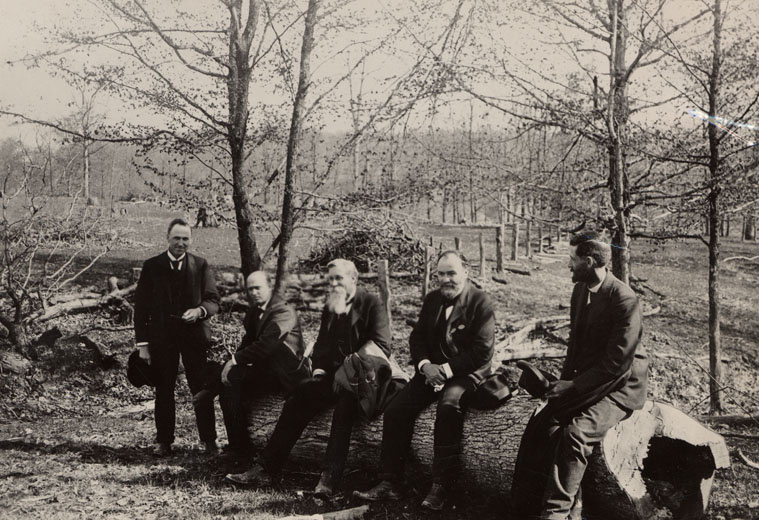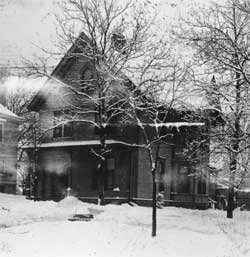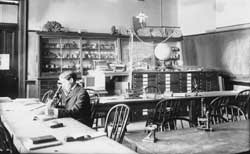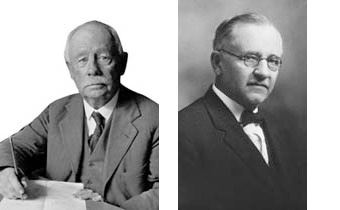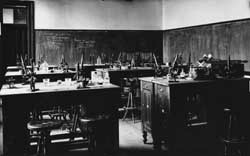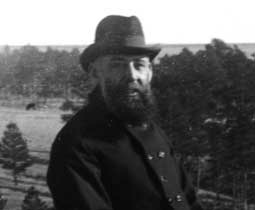Main navigation
Samuel Calvin (1840-1911)
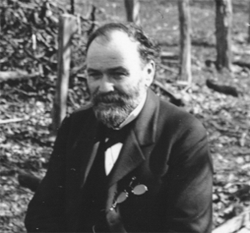
Samuel Calvin was born in Wigton Bay, Scotland, on February 2, 1840. Even as a young boy, he was an outstanding student, able to read Latin and Greek by the age of 7. In 1851 the Calvin family emigrated to the United States, first farming near Saratoga, New York, then moving to Iowa a few years later to settle on a farm in Buchanan County, south of Manchester.
By the age of sixteen Calvin was teaching at a school near Quasqueton, helping on the family farm, and was a competent carpenter. He was also becoming more and more interested in the post-glacial landscape he worked on, as well as plant and insect life. This interest led him to enroll at Lenox College (then Bowen Collegiate Institute) in Hopkinton where his studies included geology, botany, zoology, chemistry, mathematics, physics, and astronomy. However, in the spring of 1864, Lenox closed its doors as President McKean and all the male students enlisted in the Federal Army. Calvin became a member of Company C of the 44th Regiment, Iowa Infantry, and was stationed near Memphis, Tennessee. Unfortunately, the young soldier fell victim to sickness and was transferred to a hospital in Davenport. By autumn 1864, Calvin had returned to Lenox to continue with his studies. Within a short time, he became acting president of the college, and began serving as county superintendent of schools for Delaware County. While at Lenox, Calvin met Mary Louise Jackson, the tall, beautiful, intelligent daughter of Le Roy Jackson, one of the founders of the institution. They were married on September 5, 1865, after Calvin's return from the war.
Just after Calvin’s return, 16-year-old Thomas Huston Macbride arrived at the college from Cedar Rapids. This "active little fellow" as Calvin referred to him, was to be one of Calvin's greatest friends. Macbride referred to Calvin as "a studious, silent man, not given to oratory." Although the two only spent one year together at Lenox College, they met frequently during long summer vacations, making trips to distant parts of Iowa, collecting a wealth of specimens from the unspoiled prairie, and even traveling as far afield as Canada. Macbride later spoke of Calvin's devotion to natural history:
"From Lansing to Clarinda, from Dubuque to Mason City, to Winterset, to Ottumwa; athwart the state he moved; climbing all rocky heights of nature's carving, pondering the talus of every open quarry, every wall of crumbling rock, wading the creek beds, and tracing the banks of larger streams, away from home for weeks altogether...in such fashion, and not otherwise, did he win the rich experience and world wisdom presently brought in such overflowing measure to the service of the state of Iowa."
In 1869 Calvin resigned from Lenox to become principal of a school in Dubuque, Iowa where he taught science and gave public lectures in geology. His reputation grew and he was invited to deliver a series of addresses at the seat of the State University, in Iowa City. In 1873, Calvin joined the State University as "Acting Professor of Natural Science and Curator of the University Cabinet". A year later he was promoted to full professor and given a salary of $1800 a year with the responsibility of teaching all natural sciences. Calvin's classes included lectures, recitations, laboratory practice (all held in the Old Capitol Building), and fieldwork. The aim of this instruction was "to lead students as far as possible to become independent observers of nature". To assist with this Calvin was also given two microscopes "for frequent use in all the classes" and had the natural history collection - the "University Cabinet" - at his disposal. Calvin was far from satisfied with this meagre collection and so at great personal expense he made his own collections available. By 1878 Calvin needed a teaching assistant and Thomas Macbride (who was now an instructor at Lenox) was duly appointed as adjunct Professor of Natural Science with a salary of $1200 a year.
Eventually the University gave Calvin just $150 dollars for a field trip to collect new specimens for the University Cabinet. With this, and a great deal more of his own money, Calvin, accompanied by Macbride, collected specimens from Canada, New York, Lake Erie, Massachusetts, Long Island, New Jersey, Ohio, and Indiana, as well as visiting many famous institutions. Calvin's private collection formed the core of what is now the Paleontology Repository in the Department of Geoscience. For most of their married life, the Calvins lived at 522 North Clinton Street (now the residence of the Delta Delta Delta sorority). They had two children, Alice and William John, both of who received degrees from the University of Iowa. Although Mrs Calvin was of fragile health, she lived to the age of eighty.
In just two years, Macbride became "Professor of Natural Science in charge of Botany." As classes expanded and the number of students increased Calvin and Macbride pushed for a new building for the use of science, built at a cost of $45,000, on the present location of Macbride Hall. Science Hall was opened in 1885, and contained four large lecture rooms and four newly equipped laboratories for the teaching of zoology, paleontology, and botany, and ample room for the Museum of Natural History and the herbarium.
The number of students enrolled in the sciences continued to increase and Calvin was later assisted by Gilbert Houser, Charles Nutting (who later became a professor of zoology), Bohumil Shimek, and George F. Kay. Collections increased in size also and within two decades, the sciences had once more outgrown their building. A new Natural Science Building was begun in 1904 on the same site, while the old building was literally moved to the corner of Jefferson and Capitol Streets (a move for which Nutting drew up the plans). Much to their disappointment, Calvin and Macbride never occupied the new building for as soon as it was finished it was "temporarily" filled with the library and an auditorium.
Calvin held teaching in supreme regard and his lectures showed such skill and grace that they were often attended by students of English. Like his lectures, his published writings are models of clearness and precision. Moved to reflection by the haunting beauty of his environment one sultry summer evening on a field excursion, Calvin wrote:
"The grandeur and dignity with which today these hills look from a height of four hundred feet upon the placid current of the Mississippi is the same that they have worn for centuries...There is something about them, either in themselves or in their settings and surroundings, or in their associations with bygone centuries, or in all together, that stirs the soul and sends a thrill of pleasure through the mind of the appreciative observer.... What is the essence of this thing we call beauty in nature...?"
Calvin also took his knowledge to the people of Iowa, speaking at clubs, conventions, institutes, schools, and colleges, using a slide projector for his "illustrated talks". As part of the University's extension program to make courses of lectures available to communities in Iowa, Calvin was active in the delivery of a lecture series in the natural sciences, including topics such as "The Great Ice Age of Iowa", "The Geology and Scenery of the Pipestone Region", "The Face of Iowa" and talks on other states.
Calvin was also a researcher and gained a national reputation as a scientist and writer. His main focus was invertebrate paleontology and in the course of his work, he named some 30 species of fossils and had eleven species named for him. He also discovered the fossil remains of fish in the Devonian beds of Johnson County and a remarkable interglacial fauna in the Aftonian accumulations containing horse, mastodon, camel, giant stag, and giant ground sloth remains. "It was Professor Calvin," said Macbride, "who began a new epoch in the Pleistocene paleontology of North America."
Important recognition of Calvin's scientific work came in 1892 when he was appointed as geologist for the State of Iowa. Based on the earlier geologic surveys by James Hall (1855-57) and Charles A. White (1866-70), the legislature provided for a more complete State Geological Survey of "the natural resources of the state in all their economic and scientific aspects". Together with Charles R. Keyes, G. E. Patrick, and H. Foster Bain, Calvin managed to cover all but nine Iowa counties by 1909. The findings of his survey were published in the Annual Reports and the quality of the survey enabled important industrial development in the state. Although Calvin understood the utilitarian application of his work, and heartily co-operated in its material application, his sensitivity to the cultural value of his science was never subordinated. He gladly joined his skill and wisdom to the rising crusade calling for conservation and was invited to attend Theodore Roosevelt's conservation conference at the White House in 1908.
Calvin contributed over 70 scientific articles which were published in Annual Reports, the Bulletin from the Laboratories of Natural History from the State University of Iowa, American Journal of Science, Journal of Geology, and many others. Calvin was one of the founders of the Baconian Club formed for the mutual interchange of thought and the discussion of scientific topics. He was also an active member of the Geological Society of America (of which he became president in 1908), the Paleontological Society of America, the American Association for the Advancement of Science, the National Geographic Society, the Iowa Academy of Sciences, and the Davenport Academy of Sciences. He was one of the founders and editors of The American Geologist.
In June 1904, an alumni banquet was held in Calvin's honor as recognition of the 30 years of service that he had given to the University. More than 2000 of Calvin's former pupils (who by now were spread across the world) were contacted and willingly contributed to a special gift. This gift was a loving cup, specially made in New York. It was in the form of a classic Greek vase, with two handles, made of silver and lined with gold. Detailed engravings included crossed geological hammers (modeled from Calvin's own), a microscope, several species of fossil shells, a relief map of Iowa, leaves and ears of corn, the owl of wisdom, and the torch of learning. This remarkable gift bore the inscription - "Presented to Samuel Calvin by his former students upon the completion of his thirtieth year in a Professorship at the State University of Iowa, June 14, 1904." The presentation address was made by Shimek, who said -
"The crowning glory of your activity, Professor Calvin, is the personal influence which you have exerted upon our lives... it is my great privilege, speaking and acting for your former students, to present to you this loving cup, emblematic in its design and ornamentation of your achievements in the field of science, and symbolizing your sterling worth as a man, a teacher, and a friend."
Sadly, Calvin never fulfilled his desire to complete 4 decades of service at his university, and after a short illness, died in the early morning of April 17, 1911, deeply mourned by his loved ones and the whole University. Classes were suspended on the day of his funeral service at the Presbyterian Church on April 21. Calvin was buried in Oakland Cemetery.
“Professor Calvin was a great teacher and his students loved him. His simplicity, his gentleness, his love of justice and truth, his intolerance of deceit and shame, his deep sympathy, his high regard for religion, his lofty ideas— these were the characteristics by which he influenced the lives of those who had the privilege of knowing him.”
"The pervading presence of Samuel Calvin is still perceptible at the University of Iowa" wrote H. J. Thornton in his 1947 biography of Calvin. "If an institution is in part the lengthened shadow of the men who created it, the University of Iowa yet draws nourishment from the life and labour of Samuel Calvin."
